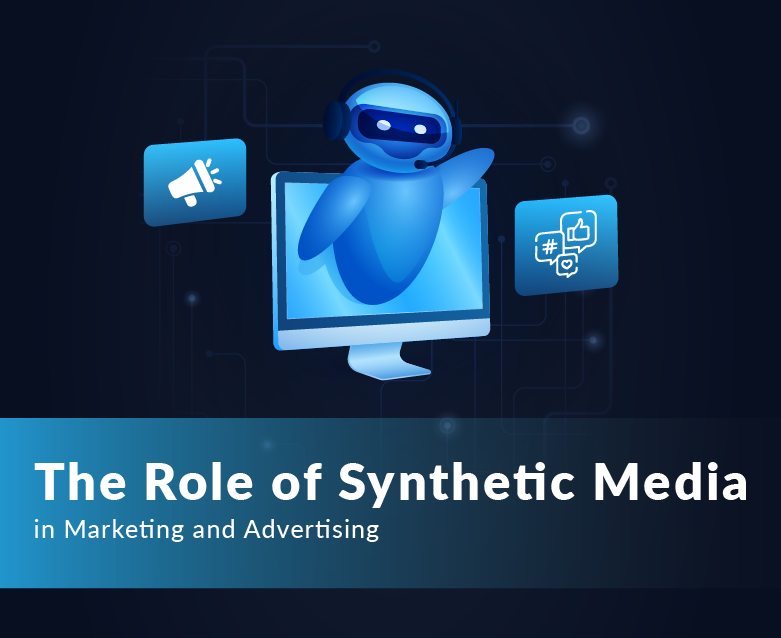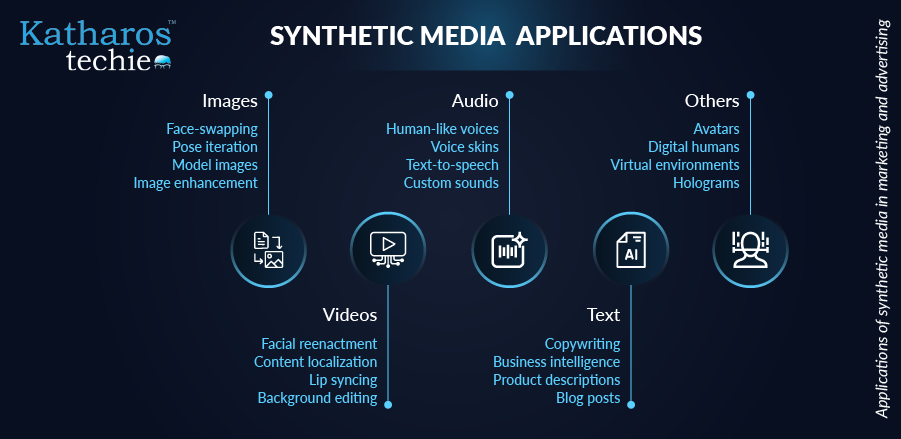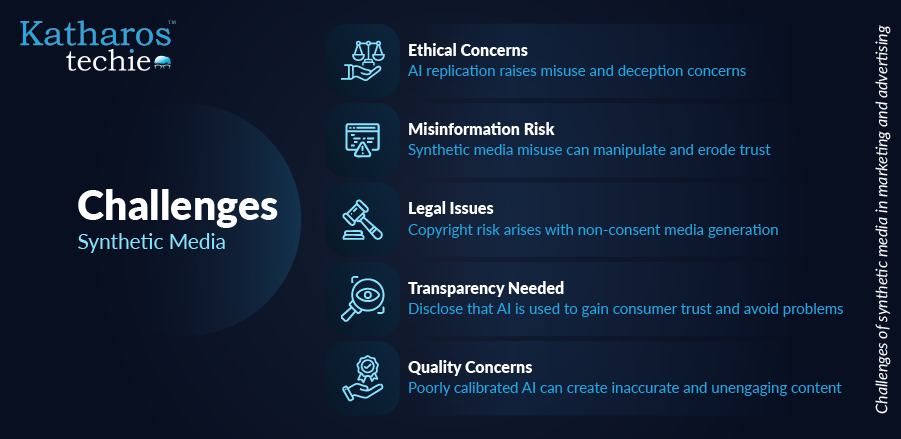
The Role of Synthetic Media in Marketing and Advertising
By Ankita Das

Synthetic media, or AI-generated media, transforms marketing and advertising by using artificial intelligence to create, manipulate, and modify content. This innovative approach produces images, videos, voices, and text using algorithms. Thus, providing new ways for brands to engage audiences and streamline marketing strategies.
The technology enables the creation of personalized and targeted campaigns by understanding customer preferences through vast data collection. This, as a result, fosters deeper relationships and boosts brand loyalty. It also allows the production of hyper-realistic product images without physical shoots and AI-generated videos with digital avatars. However, the rise of synthetic media also brings potential hazards, including the spread of misinformation.
In this blog, we will discuss the diverse applications of synthetic media in marketing and advertising. And enlighten people about how AI revolutionizes personalization, cuts costs, and boosts engagement. We’ll also address ethical concerns and challenges, offering insights for businesses to leverage synthetic media’s power responsibly. Join us as we uncover the potential and pitfalls of this exciting frontier in digital marketing.
What is Synthetic Media and Why Do We Need it?

Synthetic media refers to media content generated or manipulated using artificial intelligence (AI) and machine learning techniques. It encompasses a wide range of AI-generated content, including deepfakes, AI-generated images, and AI-generated text. The Synthetic Media Market was valued at USD 4.5 billion in 2023. Projections estimate it will reach USD 16.6 billion by 2033, exhibiting a CAGR of 14.3% during the forecast period from 2024 to 2033. This substantial growth underscores the increasing adoption and integration of synthetic media technologies across various sectors. Unlike traditional media produced by humans, synthetic media relies on algorithms to synthesize content that mimics real-world elements convincingly.
In marketing and advertising, synthetic media helps create personalized and targeted campaigns, enhancing customer engagement and brand loyalty. The technology allows rapid content creation, enabling creators to produce sophisticated content without requiring extensive technical expertise. Moreover, it can reduce production costs by generating graphics without the need for physical shoots or human actors.
However, the rise of synthetic media also brings potential risks. The technology can be misused to spread misinformation, manipulate public opinion, and erode trust in institutions. Therefore, ethical concerns surrounding privacy, identity manipulation, and the mass automation of creative jobs need to be addressed. Despite these challenges, synthetic media represents a significant advancement in media creation and consumption. Thus, offering unprecedented opportunities for innovation and efficiency.
Applications of Synthetic Media in Marketing and Advertising

Synthetic media is revolutionizing marketing and advertising by offering innovative ways to create and deliver content. From generating personalized ads to predicting consumer behavior, this technology democratizes content creation and redefines how media is planned and executed. Here are the use cases of synthetic media in marketing and advertising:
- AI-Generated Product Visuals: AI can generate photorealistic product images without physical shoots, saving time and money. Social media content creators can efficiently generate advertising images using programs such as Canva and Midjourney. For example, achieving various aesthetics faster using Gen AI tools, like creating a neon-colored, NY-style photoshoot.
- Personalized Video Content: AI videos no longer require actors, studios, production equipment, or editing. Startups use generative AI to create videos featuring talking human avatars. AI can customize videos in terms of language, culture, and design to make relatable content, increasing conversion rates.
- Dynamic Voice Adaptations: AI can replicate voices, which raises ethical concerns about misuse but also allows for personalized ads that adjust to user preferences. Social media celebrities can now speak any language they want and thus target a larger audience online.
- Targeted Advertising Text: AI can generate advertising text, enabling personalized and targeted campaigns. Marketers can generate content according to numerous market segments and media (emails, presentations, product videos).
- Cross-Platform Content Creation: AI facilitates the creation of content that can be used across multiple platforms, from social media to display campaigns. It also enables the continuous creation of novel experiences, such as interactive avatars or personalized videos. Additionally, it can help identify influencers and distribute relevant content.
Despite the numerous benefits, the use of synthetic media also presents significant challenges that must be considered when developing media planning strategies. Transparency about AI usage is crucial for gaining consumer trust and ensuring ads do not create a “real mess.”
Challenges of Synthetic Media in Marketing and Advertising

Synthetic media offers many benefits for marketing and advertising but also presents significant challenges that marketers must tackle. Here are the challenges of synthetic media in marketing and advertising:
- Ethical Concerns and Authenticity: The ability of AI to replicate voices and images raises ethical concerns, particularly regarding misuse and deception. Deepfakes, for example, can undermine trust in digital content. Synthetic imaging in political advertising might raise ethical issues around brand trust, transparency, and informed consent.
- Risk of Misinformation: Synthetic media can be misused to spread misinformation, manipulate public opinion, and erode trust in institutions. Educating audiences to differentiate between real and AI-generated content is crucial in preventing the spread of misinformation.
- Legal Issues: There is a risk of copyright infringement, especially if content is created without permission from featured individuals or companies. Businesses may face ethical issues if the media is used to manipulate or mislead their audience. Regulations are needed to protect consumer rights, prevent misuse, and ensure ethical practices.
- Maintaining Transparency: Consumers are more likely to find AI-generated ads appealing if companies disclose the usage of the technology. Transparency about AI usage gains consumer trust and prevents synthetic ads from creating problems. Influencers should disclose the use of AI programs in their content production, though many are hesitant to do so.
- Quality and Accuracy: Synthetic media generated through machine learning may need more quality and accuracy if the algorithms are not correctly calibrated. This may lead to content that fails to align with business goals or capture the target audience’s interest.
Navigating these challenges is essential to harness synthetic media’s benefits while mitigating risks. Clear communication, user consent, ethical AI collaboration, and regular assessments are crucial for transparency and trustworthiness. Brands must address ethical and regulatory concerns to connect effectively with audiences and safeguard their reputation.
Final Thoughts
Synthetic media offers transformative potential and complex challenges in marketing. Careful navigation allows marketers to harness its power for increased brand awareness, customer loyalty, and engagement. Creative teams must proactively address unforeseen implications, establish safeguards, and govern responsibly. Embrace synthetic media wisely to unlock its potential and shape an ethical marketing future. What steps will you take today to harness synthetic media responsibly? Share your thoughts below.